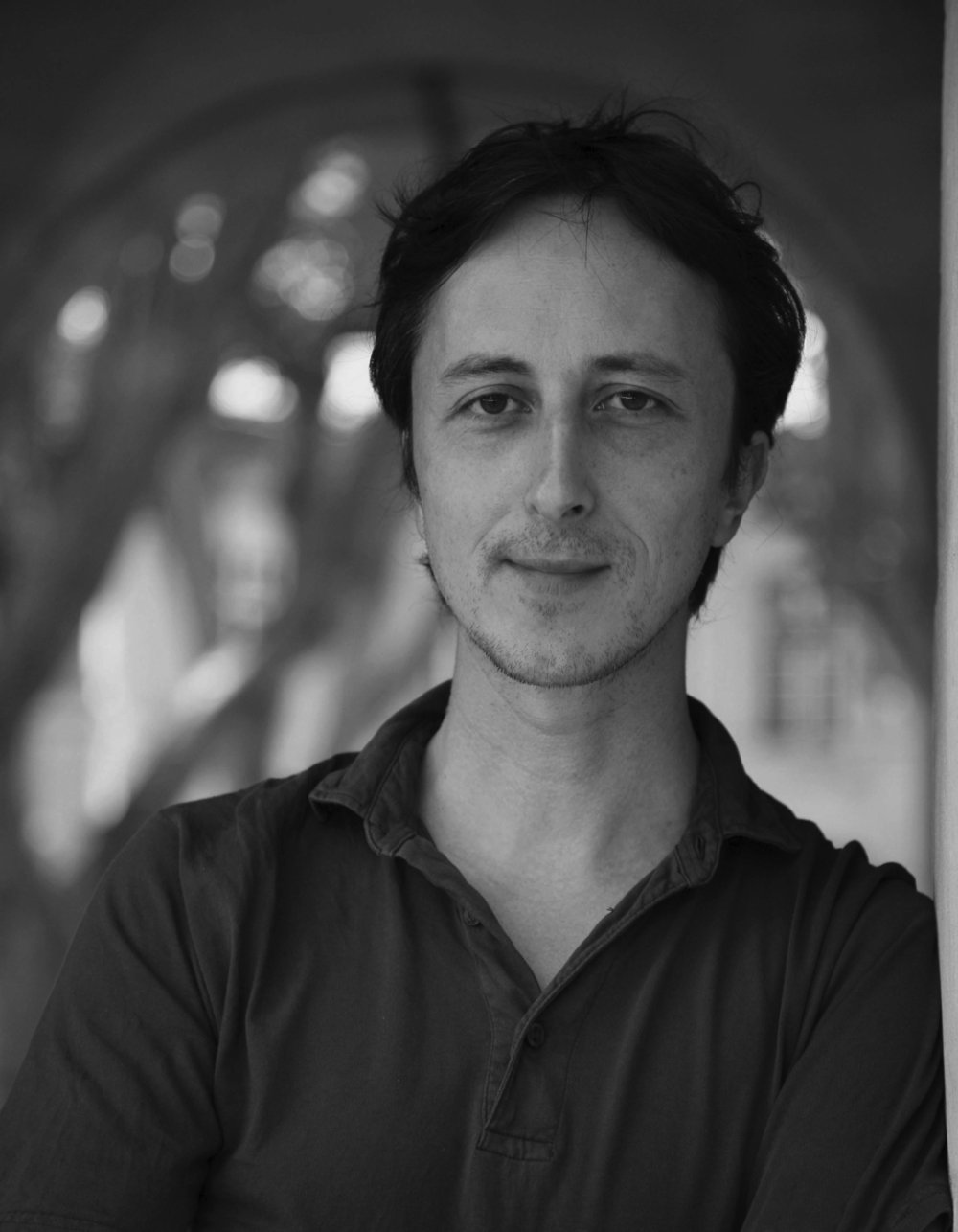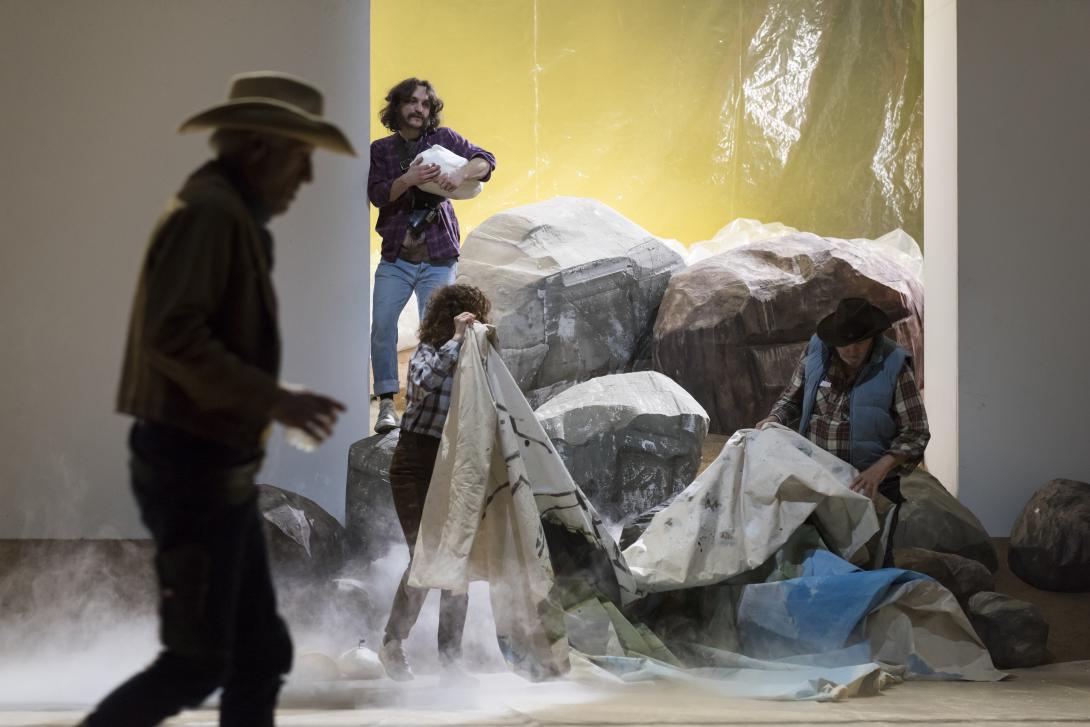A French cowboy in Munich
a conversation with Philippe Quesne
Men in cowboy hats, plaid shirts, and cowboy boots behold a mountainous skyline against a sea of clouds. In Caspar Western Friedrich, Philippe Quesne and Münchner Kammerspiele combine the boundless landscapes of the Romantic painter Caspar David Friedrich with the rugged nature of the western genre. The result is a space that blends museum, studio, and theatre set. Quesne : ‘I have often thought that theatre staging is a question of painting.’
Caspar Western Friedrich brings together the Romantic painter Caspar David Friedrich and the lone cowboys of the western genre onstage. Why have you combined these two figures?
To me, the theme of the western genre has always been the cowboy’s quest as he travels across the landscape. I see an analogy between this and the Romantic paintings of Caspar David Friedrich, who often places pensive figures in perspectival landscapes that are reminiscent of travel and distant horizons. The title is a play on words. The western genre and Romanticism offer me the opportunity to use landscapes to address the current search for an ideal. Although conquest – violence, war, murder – is typical of westerns, the context of the Napoleonic Wars also plays a role in Friedrich’s work, which also represents the spiritual quest of a painter talking about humanity and nature – and not only about war.
Theatre in general, and my work in particular, raises many questions about the perception of the stage as a studio. I didn’t choose Friedrich to act out his life story, but rather to use his work as the inspiration to create a poetic gesture. And this gesture required us to recreate his studio almost identically on stage. There are numerous references to the studio – which was a simple wooden structure – where he painted behind closed curtains. He had a very particular relationship with reality. He rarely painted in the open air, so his landscapes are actually imagined reconstructions. In some of his paintings, he constructed a poetic natural landscape from collages of forests and mountains that did not correspond to reality whatsoever.
Friedrich painted perfect natural tableaux. Nature was more of a self-devised collage than a reality. Nowadays, nature is increasingly being perceived as a construction or an illusion. Is that why your characters depict nature in the form of a painting hanging in a museum?
When I started working on this piece, that was the basic idea. But the reconstruction of nature onstage was also a central theme in La Mélancolie des dragons (2008) and Swamp Club (2013). I have often thought that theatre staging is a question of painting. How do you present artificial nature onstage and create a dream vision for the audience? I identify very strongly with Friedrich’s compositions. His constructed nature and staging of bodies in the space are Romantic aspects that recur in my work too: people walking through fake snow, actors who live in the Swamp Club. I take the time to observe both bodies and voices on the stage as materials, objects, colours, smoke and light. For more than ten years, I have been trying to construct ‘micro-worlds’. In Caspar Western Friedrich, that world is quite literal because you see cowboys build a museum and install a museum room focused on this painter and Romanticism.
I do not use real materials for this micro-world. A reconstruction of reality always has an aspect of being cobbled together. We show a rock, for example, but also the polystyrene foam from which the rock is made. I love that kind of poetry. Otherwise I would just take the audience on a hike in nature, real nature. The theatre is a transposition of the real world, not an imitation of it.
What is the origin of our desire to keep reproducing images of nature? What do we project of ourselves into that image? And what happens when we see that image onstage?
I enjoy reconstructing worlds on the stage, but I find it difficult to articulate why I do that. I just hope that watching the piece makes the audience feel free and want to go and paint or read. It is almost like campaigning for more art in life. Painting, reading, writing, listening to music… that is what all my fables are about. I am not interested in staging tragedies. At the moment my world is more like post-Romanticism! In any case, humanity’s relationship with nature has fascinated me for a very long time. Might that be because as a theatre director, you constantly live in a black box, a long way from fresh air and walks in the woods?
You bring disparate worlds together on the theatre stage: the world of museums with paintings and actors who do not only perform but also build and dismantle sets. It is presumably not a coincidence that you are presenting this piece during Performatik, a festival at the intersection between the performing and visual arts?
The production is a reaction to the recent trend of programming dance or moving bodies in museums. You would almost think that there is a kind of fear of simply showing paintings or sculptures; a fear of things that are not live. At the Louvre, for example, you can increasingly see classical concerts being performed amongst the works, instead of just exhibiting paintings. This ‘entertainment’ is primarily the initiative of the museums themselves, not of the artists. It is true that in this production, I approach this issue with a certain irony, and the cowboys could be interpreted as the perfect museum guides or entertainers.
On the other hand, Caspar Friedrich wrote a beautiful text in which he plainly admits to preferring a spatial presentation of multiple paintings, rather than a single painting. He even suggests that his work should be combined with light and music. So that is a very avant-garde proposal, with scenography and staging. Friedrich was friends with musicians and authors who were also part of the Romantic movement. There was a lot of cross-fertilization between the arts. That is not new. I think the debate about so-called oppositions between theatre, museums, dance and text is a false modern dichotomy. There is currently a strong tendency to introduce the visual arts into the performing arts. Conversely, perhaps it is now very modern to display one painting in a big museum?
Why do you think the western genre is so apt to show that tension between the experience of time in a production and the museum time of looking at an artwork?
In westerns, there is always a moment of stillness. The characters rest and fall asleep in the desert, near a rock or a horse. In those days, the focus was on building cities, discovering America and looking for gold. But there was also always a hesitant attitude, almost like in Beckett: the cowboy Beckett who is not really sure why he is supposed to conquer anything and how to find his place in the world. Characters in that state of mind provided the inspiration for numerous songs about existential problems. What I like about westerns is that motionless journey: the cowboy sitting in a chair with his guitar, singing about great adventures in the desert. To me, Friedrich’s work is the ultimate motionless journey. In theatre, the journey is just as motionless.
Looking for new worlds, which is so typical of westerns, is also a common theme in art and poetry nowadays. Perhaps we should read more poetry or look at more art to find alternative, utopian solutions for our planet. Painters show us possible ways of doing that in different styles and in different periods. I think it is extremely important that Caspar David Friedrich shows humanity as something that is part of nature instead of being superior to it. People are simply part of the landscape; they do not dominate it.
You did not collaborate with your usual company for this production, but rather with the Münchner Kammerspiele. How did you establish this cooperation? And what was the creative process like?
It was actually commissioned by the repertoire theatre in Germany. In addition to actors from the Münchner Kammerspiele, Johan Leysen is also in the production. He is a freelance actor and a European cowboy of the theatre. My method was the same as always: I created the piece with the actors and they inspired me. We read a lot of texts together and looked at footage from westerns and Friedrich’s paintings in museums. But I still felt a little like a French cowboy in Munich. German theatre is organized very hierarchically. Set building is very structured there. There are technicians at every level and dozens of set builders. That was all rather exotic to me. I usually work with a small group of trusted collaborators and we make everything ourselves. Many of the texts and poems were suggested to me by the actors. For example, Peter Brombracher, the oldest of the actors, is a very romantic person. His career has criss-crossed the whole of German theatre history. Just like Johan Leysen, he has a close relationship with the text. The actors are brimming with texts. They carry their own museum with them!
Philippe Quesne in conversation with Esther Severi and Eva Decaesstecker (Kaaitheater)

